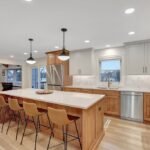Designer cabinets enticing us with high-end décor accessories and fixtures can feel impossible to shun, but experts recently confirmed it’s more than a feeling. More than half of the population of designer cabinets showcased in interior design forums online and elsewhere are often optimized to hit our bodies’ dopamine, exploiting our biology to keep us admiring and paying more.
While they are ubiquitous, designer cabinets are too good to be true. Rather than waste money on them, why not consider making your cabinets from scratch? We discussed with experts, about tips for making cabinets from scratch to inspire homeowners to update their house décor for fall.
If you are planning to remodel your kitchen or living room, continue reading to find inspiration.
About Making Cabinets from Scratch
Honestly, making cabinets from scratch equals turning a concept or idea into an actual object. It is an overwhelming and eye-opening task that calls for a range of tools, materials, and supplies. What’s more, it can help one save thousands of dollars and simultaneously hone skills related to carpentry while enhancing aptitude for numbers through measurements.
To build cabinets on your own, you need to possess the following;
- Skills
From performing a range of measurements to cutting woodwork and binding together materials, the process of making cabinets calls for specific skills. Unless you possess the skills, you will hardly record success while making a cabinet box, no matter how long you keep trying. Fortunately, most of the skills are easy to learn, practice, and master.
- Money
With a good amount of money, you can easily get all the supplies, materials, and tools you need to be successful in making cabinets. If you launch a cabinet-making project without seeing the need to save more cash, you may face constraints when it comes to consolidating everything you need for the project to be a success.
- Essential Tools and Supplies
Besides skills and financial resources, you must own specific tools and equipment to build cabinets from scratch. From hacksaws and hammers to screwdrivers, and wood glue for joining and reinforcing cabinet bases. With the right tools and suppliers, you can enjoy convenience while constructing cabinets like a pro.
The Process of Making Cabinets from Scratch Explained
- Planning for the Project
Just like a journey of a thousand miles begins with careful planning, the process of making cabinets from scratch must be based on proper planning. When planning for a cabinet-making project, there’s more you are bound to do, including creating a checklist of essential materials and taking measurements of the space in which the proposed cabinets will fill.
You need to know that it is in the planning stage where you may choose to establish a blueprint for the cabinets you aim to build. With a good blueprint, you can determine the most proper dimension for your dream cabinets. A good plan must be realistic and flexible enough to align with inadequacies or constraints that may crop up in bids to source some materials and fixtures.
- Gathering Materials and Supplies
After drawing a plan for making cabinets, you can proceed to gather essential materials and supplies. Having a checklist can help you avoid forgetting important items without which you cannot finish a cabinet-making endeavor. In terms of cabinet material components, whether you go for solid wood or lightweight varieties of natural wood, the material you choose can dictate whether your cabinet-making exercise will be easy or difficult.
Nevertheless, you need to know that plywood is the best-known material for cabinets. Depending on your preferred cabinet styling options, you can also choose to work with non-wood materials, for example, metals and laminates. In general, most of the materials and supplies you may need to construct cabinets can be found easily in hardware stores.
- Cutting Material Pieces for Bases and Panels
After gathering essential materials and suppliers, you can proceed to divide plywood or any material at your disposal into panels to use as cabinet sides, base, and panels. Whether you are looking to make a wall or base cabinets, the measurements you choose for their bases and panels must reflect not only your tastes but also the aesthetic orientation of your home. Interior design experts can help you discover standard measurements for cabinets to install in living rooms or kitchens.
Note that the projected size of your dream cabinets will determine the number of top, bottom, and side material pieces you need to cut. If you are constructing wall and base cabinets, you should not be surprised to find out that their parts differ, especially in terms of measurement and depth.

- Assembling Material Pieces
After cutting material pieces for cabinet sides and bases, you should proceed to bind them to the panels. You can use glue, screws, or small nails to reinforce their contact. Using butt joints, you can link the sides to the base before securing top brace panels. At this point, it may be good for you to employ the service of a clamp to hold material pieces in their places.
To secure the frame of your brand new home-made cabinets, you should dig corner brackets through which you can drive screws. Corner brackets will also allow you to install shelves and doors in an aesthetically appealing way.
- Painting and Ornamentation
After successfully making cabinets, you should take time to paint and accessorize them, unless you don’t want them to seem both brand new and attractive. Arguably, there’s a lot to consider when it comes to choosing the right paint color for cabinets, including the cabinet’s material texture and the overall visual aesthetic of your room, not to mention your preferences.
If you try consulting paint experts and professional organizers, you may learn two or three things about the right colors and color combinations for cabinets. All in all, it may be good if you consider neutral paint colors. Unlike bolder shades, neutral colors can blend well with multiple interior design aesthetic styles and are easy to take care of.
Final Thoughts
If you are not ready to waste your money on buying cabinets that seem too good to be true, you should consider home-made cabinets. Making cabinets by yourself can let you simultaneously save your dollars and determine how you want your home to look without clinging to the views of interior design experts.






